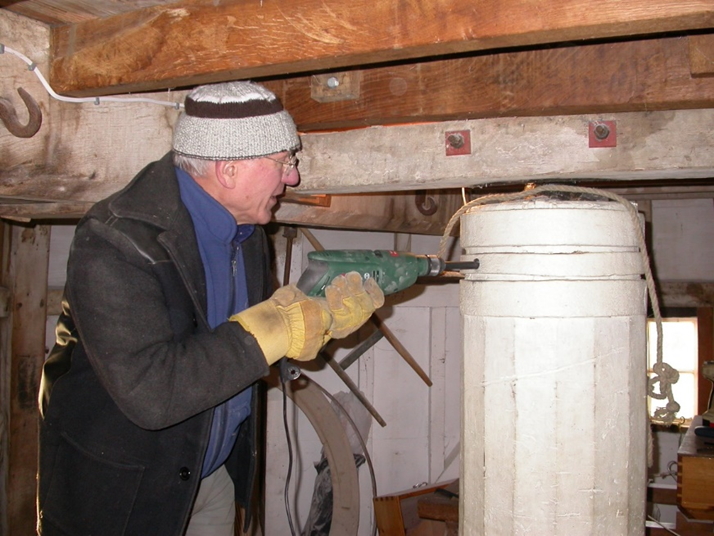Dave Pearce
Wicken Windmill Partnership
| Mike Newland died aged 86 on 15th February. He was a kind, private man, with no time for ‘show’. He had many abilities and skills, and in particular was of the utmost assistance in resolving mechanical engineering challenges during the long restoration of Wicken Corn Windmill. Mike and his wife Mary devoted very many days and hours to Wicken Mill, which was in an extremely poor state when the restoration started in 1987. Every summer their camper van would arrive on site from their retirement home in East Sussex for the ‘work-in’ season, and between times work would go on in his home workshop. On behalf of the Wicken Windmill team, we send our condolences to Mary and the family, and remember with gratitude the many years of friendship and craftsmanship which Mike gave us. | |

| The following is something of a millwrighting obituary for Mike. Particular jobs in which he was prominent include: Roller Runner Plate retaining bolts The milling business at Wicken was brought to a stand in 1933 by a combination of millwrighting and economic problems. The mill has a shot curb. Latterly free movement of the cap and roller race were prevented when the roller runner plate attached to the underside of the cap came adrift at one location point and dropped between rollers. The cap jammed, and could only rotate in one direction. | |
| A new roller runner plate was made at the restoration, of long lengths and slightly heavier section. Special retainer bolts were designed, which could be replaced should they shear off in service. The retainers consist of specially made stainless steel studs, each of appropriate length to pass through the cap timbers: weather beam, tail beam or cap circle. At the top of each stud is a ½”BSW or 9/16”BSW thread. At the bottom each stud was internally threaded to suit a 5/16”BSW Allen Bolt. Mike agreed readily to make these specials in his home workshop. Over the years one has fatigued in service, but was replaced according to plan: the winding gear was out of action only for a few hours. Newland shutter crank bolts On restoration the Wicken Mill sail shutter cranks were connected to the working uplongs (coupling rods) by stainless steel coach screws. These screws had a tendency to work loose and fall out. A replacement design was needed, simple to use and fit, but which would not work loose. | |
| It was not a new problem – Mr GC Wilson came up with an old Lincolnshire shutter bolt, specially forged, which could be lock nutted in place. A new stepped bolt design was worked up, retaining the essentials of the Lincolnshire shutter bolts. The design could be turned down from commercial 10mm stainless bolts. Mike took on the skilled job of making the bolts, all 208 of them, which he made up in his home workshop. Ever since these special bolts have been universally known, at least at Wicken, as Newland Bolts. The Jumper, and actuator Wicken Mill has three flour dressers. Of these the wire machine is in regular and frequent use. The centrifugal dresser is in need of refurbishment, and the jumper which was designed as an experiment was built for us by Mike. The jumper (jogger, jog scry) is essentially a sieve intended to separate fine flour particles when shaken up and down. It is driven by an eccentric on the northern stone spindle. It was soon realised that on its own the eccentric shook the sieves far too gently. Mike ingeniously interpolated a ratchet between the eccentric and the jumper, so that the sieve trays would drop suddenly and uniformly no matter how fast or slow the windmill sails were turning. Being built by Mike the eccentric and ratchet device is beautifully made. In Mike’s memory we will continue to experiment with the jumper. The Model Mill Mike made a magnificent scale model of the windmill, displayed in a show case on the ground floor of the mill. It is in full mechanical going order. It is one of the treasures of the mill, to be carefully preserved. The Wooden Bevel gear Mike made a copy of the unusual wooden bevel gear from the fantail winding train. This fine piece of work is kept ready in case of serious failure of the replica wheel fitted at the restoration. The original wheel was somewhat fragmentary, and is preserved amongst the mill’s museum material. Repairs to the Upright Shaft One evening in January 2009 the mill was running normally, driving a single pair of stones, when miller Alan Wallis was disconcerted to find that the sails were still turning but the stones were suddenly stationary. The upright shaft is essentially timber, with an iron coupling between upper and lower sections. Investigation showed that the coupling had failed: gradually the fins let into the lower timber shaft had failed one by one. Vincent Pargeter suggested an interim repair. Drilling through the wrought iron rings binding the lower shaft to the coupling allowed steel rods to be driven through radially, eventually in three locations. Mike can be seen in the photo drilling one of the holes, easier said than done. The iron rings were very hard and the weather cold. The repair was successful, so much so that it’s still in use. So farewell Mike and thank you again for all your friendship and help. | |

You can find out more about Wicken Mill in the millwright’s databook, available on our catalogue here.


